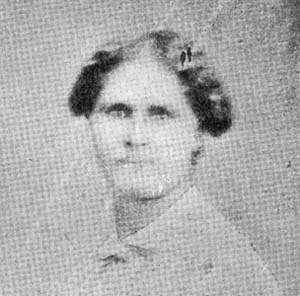Caroline Quarlls facts for kids
Caroline Quarlls (1826–1892) was a brave young woman who escaped slavery. She was the very first enslaved person known to travel through Wisconsin using the Underground Railroad. This secret network helped many people find freedom. In 1842, Caroline reached Canada and became free.
Many people who believed slavery was wrong helped Caroline on her journey. Even though people tried to catch her, she made it to safety. In Canada, she married a man who had also been freed from slavery. Her full name then became Caroline Quarlls Watkins.
Caroline's Early Life
Caroline Quarlls was born in St. Louis, Missouri, in 1826. She was born into slavery, owned by her own grandfather. Her father, Robert Pryor Quarlls, was also her owner. Caroline's mother had married a successful blacksmith who was born free.
By the time Caroline was sixteen, her mother and aunt had passed away. But Caroline had a kind stepfather who talked to her about escaping slavery. Caroline worked as a housemaid in St. Louis. Even though she looked like her half-siblings, she was not given the same freedom. After her father died, she became the property of her aunt, Mrs. Charles R. Hall. Caroline was sometimes treated harshly. She was very smart and could read, but she never learned to write. She spent her time doing fine sewing, embroidery, and serving her mistress.
Her Journey to Freedom
When Caroline was a teenager, her mistress became angry with her and cut off her hair. Caroline decided she had to escape. She managed to get permission to visit a sick friend. On July 4, 1842, the 16-year-old threw a bundle of clothes out a window. She picked them up and walked to the ferry. This was the start of her journey on the Underground Railroad.
Caroline had taken $100 from her former owner. She bought a ticket for a steamboat to Alton, Illinois. Because she was of mixed race, she could pretend to be a white girl. She traveled by stagecoach through Illinois to Milwaukee. People who wanted to catch runaway slaves were looking for her. There was a $300 reward for her return.
Caroline stayed for about a week with Robert Titball, a barber who had once been enslaved. Titball told slave-catching lawyers that Caroline had been at his home. But a Black boy who worked for him warned Caroline. He helped her hide in a container on a boat. She was taken across the Milwaukee River by a lawyer named Asahel Finch.
From Milwaukee, Caroline traveled to Pewaukee with Samuel Brown. They rode in an old, shaky wagon. Brown then took Caroline to the home of Lucinda and Samuel Daugherty in Lisbon, Waukesha County. There, she met Lyman Goodnow. He was a "conductor" on the Underground Railroad, meaning he helped guide people to freedom.
Sometimes Caroline walked, and other times she hid under hay in a horse-drawn wagon. They traveled on dusty trails and sometimes in heavy rain. They stopped at secret "stations" on Wisconsin's Underground Railroad. These included places like Prairieville (now Waukesha), Spring Prairie, and Gardner's Prairie near Burlington. From there, they continued into Illinois.
Caroline and Goodnow learned that the clerk from the steamboat she took to Alton was also looking for her. He would have to pay her former owner $800 if Caroline wasn't found. At a schoolhouse, Caroline saw a "liberty pole." She learned that these poles were common in northern villages. They celebrated the birth of freedom in the United States.
They continued their journey through Illinois, Indiana, and Michigan. Slave hunters and lawyers kept chasing them. Caroline and Goodnow made their last stop at the home of Guy Beckley in Ann Arbor. This was the final stop before Detroit. From Detroit, they crossed the Detroit River into Canada. Goodnow guided her about 31 miles (50 km) into Canada. People who supported the abolitionist cause gave them supplies for their journey across the border. Caroline's journey to freedom lasted five weeks, crossing through many states into Canada.
Life in Canada
After arriving in Canada, Caroline went to school for her first year. Three years later, she married Allen Watkins. He was an older man who had also been freed from slavery. Allen was a cook, and he and Caroline worked hard. They made a good living for their family.
Caroline learned that she had been left some property back in St. Louis. She would have received it if she had stayed there until she was old enough. But she chose freedom instead. Caroline and Allen raised three boys and three girls. All their children received good educations.
Caroline kept in touch with Lyman Goodnow, the man who helped her escape. She wrote him a letter, saying:
Dearest Friend: Pen and ink could hardly express my joy when I heard from you once more. I am living and have to work very hard, but I have never forgotten you nor your kindness. I am still in Sandwich—the same place where you left me. Just as soon as the Postmaster read the name to me—your name—my heart filled with joy and gladness and I should like to see you once more before I die, to return thanks for your kindness toward me. I would like for you to send me one of the books you were speaking about.
—Caroline Watkins, Sandwich, Ontario
Caroline Quarlls Watkins passed away in Sandwich, Ontario in March 1888 or 1892.
See also
 In Spanish: Caroline Quarlls para niños
In Spanish: Caroline Quarlls para niños


